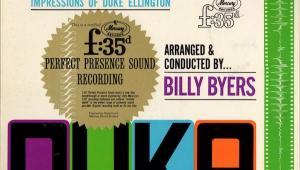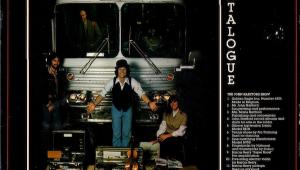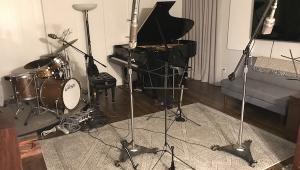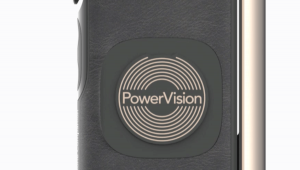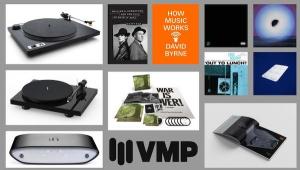An integrated amplifier with just three inputs, one of which is phono-only? Jesus wept, some hi-fi manufacturers haven't learnt a bloody thing, have they?
Rega Research io Integrated Amp With Built-in Phono Preamp—A Cautionary Tale

The unit’s back panel neatly houses the three inputs (two analog RCA line inputs and one phono input, plus ground lug). The integrated moving magnet phono preamplifier is set for a sensible 220pF capacitance. The back panel also holds the AC input and banana plug and bare wire compatible speaker terminals. The attractive glass (or glass-like plastic) front panel houses the unit’s volume controller, input selector, on/off button and 3.5mm stereo headphone jack, which outputs 1.6V at 32Ω, 2.4V at 54Ω, and 5.7V at 300Ω. The source impedance is 109Ω. The io’s power amplifier stage drives the headphone jack using relays to avoid signal degradation when using headphones.
Rega houses the unit’s components within a sleek 160 x 68 x 290mm metal black chassis weighing 2.9kg, the design of which matches the compact remote control. Powered up, the front panel input indicators and company logo glow deep red. Though not the unit’s selling point, the io easily passes a visual test and stylistically fits well into any reasonably modern home. However, from a financial standpoint the io must make a sonically strong case against much more affordable and readily available AV receivers.
The AV receiver's deceptive appeal is why entry level integrated amplifiers struggle like no other product type; AV receivers, with their ridiculously low price tags and unbelievable functionality provide tough competition for traditional integrated amplifiers. Believe it or not, many inexperienced audiophiles believe upgrading electronics is not a worthwhile investment. Of course, many who rightly ridicule such foolish beliefs have spending power beyond the entry level price point.
Therefore, an entry level integrated amplifier’s key task is demonstrating to skeptics that it offers sound quality far superior to that of competing AV receivers. Failure to do so means another AV receiver is sold. Is Rega’s entry level offering a recommendable piece or not? Will it send AV receiver shoppers down the more costly, purpose-specific audiophile rabbit hole we all love diving into?
Over the review period I used both the KEF LS50 Metas (recommended 40-100 watts at 8Ω) and the ELAC Uni-Fi 2.0 UB52s (recommended 40-140 watts at 6Ω). Both are relatively inefficient 85dB loudspeakers. Though the io’s 30 watts at 8Ω falls under the KEF LS50 Metas’ recommended 40 watts at 8Ω, many dealers regularly recommend an io/KEF LS50 Meta pairing. Questionable as that is, especially when the Brio pairs much better, the KEF LS50 Meta analysis here serves to inform the many KEF LS50 Meta shoppers. For vinyl playback I used the MoFi StudioDeck turntable and an Ortofon 2M Black LVB 250 phono cartridge. Though my speaker wires are generic, I used AudioQuest Golden Gate RCA interconnects and AudioQuest Evergreen RCA interconnects.
The KEF LS50 Metas
The $1599.99 ($2299.99 CAD) KEF LS50 Metas are stand-mount loudspeakers boasting outstanding transparency and holographic imaging. It’s this transparency that—through extensive listening—will reveal the Rega io’s sonic characteristics.
After two months of constant observational listening, I found The Bee Gees’ “Spirits Having Flown” best revealed simultaneously the Rega io’s strengths and weaknesses. Instrumentally, the song’s initial verses feature both electric and acoustic guitars, bongos, standard rock/pop drums, an electric bass and of course the Gibb brothers’ vocals, primarily Barry’s. All throughout the verses, the LS50 Meta/io combo perfectly reflected the tune’s calming Caribbean-inspired energy. The combo presents with great detail and lifelike proportions Barry Gibb’s gentle, airy vocals, while the instruments, whether acoustic or electric, all sound involving and timbrally natural.
The io also delivers decent soundstage width and depth; for example, John Lennon's "Oh My Love" with its extreme right and left channel piano tracks is a perfect track to evaluate a system's ability to convey soundstage width. The LS50 Meta/io combo places each piano track beyond the right and left speakers, just how John Lennon wanted it. However, having repeatedly heard this track—almost religiously so—I must confess I've heard relatively similar-league amplifiers such as Cambridge Audio’s $699 AXR100 amplifier place the tune's pianos even further beyond the speakers' extremes. Soundstage depth is equally sufficient, placing singers well behind the loudspeakers. However, when playing multi-layered orchestral pieces like Jacob Collier's "Once You" where soundstage depth entirely determines the orchestra's believability, I've surprisingly heard better using within this same system lower-priced, higher-output receivers like my $650 7.2 channel Onkyo TX-NR626 that outputs 115 watts at 6Ω (two channels driven). That may sound unbelievable, but it’s a true observation no doubt produced in part by the Onkyo’s almost quadruple power output. Though, the differences are quite subtle and the Rega io's soundstage depth and width supports a believable, three-dimensional illusion. The io takes an intentional approach playing such orderly and acoustic-driven music; calm and pleasing songs like our first example “Spirits Having Flown” please and calm the listener, as the artist wanted. However, large-scale dynamic shifts produce problems.
The “Spirits Having Flown” chorus, in which the volume quickly jumps, introduces a blazing synthesizer; the io suddenly faces a significantly more difficult task and can't quite achieve the desired result. Once the dynamics shift, the air previously surrounding the instruments disappears. Consequently, spatial cues disappear and the musical presentation loses its previously-held distinctiveness. More noticeably, at high dynamic peaks the vocal quality suffers immensely. It’s not subtle. What was previously airy and detailed is now piercing and obnoxious. No matter what pressing or format I listened to, the results were the same. Nothing source-wise could alter the io’s disturbing dynamic mishandling. Clearly the amp “ran out of gas”; a 30 watt per channel amplifier should not drive a speaker demanding a minimum of 40 watts per channel. Still, I thought to hear what might happen, especially when dealers often recommend the pairing.
The ELAC Uni-Fi 2.0 UB52s
While reviewing the ELAC Uni-Fi 2.0 UB52s I applauded their ability to reveal a recording’s flaws while otherwise sounding natural and three-dimensional. I also noticed just how relaxed ELAC loudspeakers sound. As we’re dealing with upper frequency troubles, though, a relaxed speaker may evade the high frequency “hardness” Rega’s io produced through the KEFs .
Though the Uni-Fi 2.0 UB52s produce a somewhat more relaxed sound on top and might mask some of the sonic difficulties more easily heard through the KEFs, the equally inefficient 85dB ELACs proved too difficult a load for the io to drive when presented with heavy dynamic workloads during well-mastered reference tracks. Again, the paired loudspeakers revealed a choking amplifier, though the problem was less obvious on the more forgiving sounding speakers. As before, vocals were most seriously affected. Perhaps the Rega io would perform better with instrumental music.
I listened to Immanuel Wilkins’ elegant “Fugitive Ritual, Selah” off his recent album The 7th Hand, which is a lower volume track. I wanted to hear how the io handled a more manageable large-scale dynamic load. Here, the amp showed me what it’s really made of; throughout the song, I heard nothing but pinpoint imaging, gripping transients, and a sublime low end presence. The io made crystal clear subtle volume changes in Wilkins’ guiding saxophone melody. Facing this more manageable load, instruments possessed “air” again. I could practically feel the saxophone’s damp, woody reed. The music simply had texture. This listening test demonstrated the io’s strongest sonic capabilities. Unfortunately, across a wider musical spectrum, these were short-lived moments—at least when asking the low powered io to drive a relatively inefficient speaker.
The Headphone Output
When comparing the Rega io’s speaker output with its headphone output, it’s shockingly clear what listening crowd this piece serves. Put briefly, while pairing loudspeakers demands more careful thought,the Rega io’s headphone output offers a practically foolproof headphone user solution.
Listening through entry level and therefore fitting 55Ω AKG K240 semi-open “studio” cans, the headphone output duplicated all of the good qualities showcased during lower volume loudspeaker experiments. Through the K240s, large and small scale dynamic shifts were more evident, instrumental separation was more obvious, transients remained superbly clean, and most importantly there was no diminution of dynamic peaks. Could the io duplicate through more efficient easier to drive speakers what it managed through the headphones? I can only speculate. It didn’t manage that through the on-hand speakers, but through headphones the io demonstrated all of the sonic attributes Rega’s integrated amps have always delivered.
Integrated vs. Dedicated Phono Preamplifier
As expected from a company that began as a turntable manufacturer, the Rega io features a phono preamplifier. What I didn’t expect from one built into a moderately priced integrated amplifier was one capable of producing palpable midrange richness and three-dimensionality. Singers appeared well-defined in three-dimensional space. Instruments were solid, well defined objects. In these regards the Rega io simply excels. However, compared to my Six Acoustic York phono preamplifier, the io’s phono’s backgrounds were obviously noisier. The Rega io also sounded rougher around the edges—the York overall sounded more refined. The York also produced superior soundstage depth, width, and height. Of course, the York costs twice as much as the Rega io. Those without a dedicated phono preamplifier will find the io’s built-in will serve them well until they are ready for a more costly dedicated unit.
Conclusion
Based on my experiences with the Rega io, it definitely makes for a superb headphone amplifier. Headphone listeners will adore the Rega io’s sonic characteristics alongside its small, sleek physical footprint. Those seeking low-level background music may also appreciate the piece’s potential. However, given its relatively low power output one must take great care in choosing loudspeakers. Neither the 85dB efficient KEF LS50 Metas nor the ELAC Uni-Fi 2.0 UB52s were well served by the io. Perhaps driving more efficient speakers the io might not produce the listening fatigue I experienced. Those crafting new systems must carefully pair their new Rega io with suitable and efficient loudspeakers. Those with a preexisting system including higher-output AV receivers likely haven’t thought as deeply about loudspeaker pairing. If you’re ditching your AV receiver for Rega’s io, please ensure your loudspeakers are either efficient or you’ve budgeted for new, more efficient loudspeakers. Pairing inefficient loudspeakers with the Rega io will only send beginner audiophiles back to their AV receivers where a recording’s detail, dynamics, and three-dimensionality often die. What’s certain is that dealers recommending the io to drive the KEF LS50 Metas are doing their customers and Rega Research for that matter a great disservice.
(Nathan Zeller is a Beatles fanatic and passionate audiophile found in Western Canada. Currently, he’s curating his record collection, trying to decide what music truly reaches him. It’s an exhausting, though extremely rewarding process.)
- Log in or register to post comments


If one is looking at this basic integrated, he/she is not worried about 100 connections to hook up reel to reels, cassette decks, ...you name it. Dac and maybe a CD player is about it. Or a TV input in place of one. Some people could win a $50 million dollar lottery and will "bitch" they have to drive to the bank to cash the check.

and one could connect the CD-player to the DAC. Might even sound better.

The UK market for which the IO is made had some percularities. People own property which is for the most part an almost tiny "half-house" with a small livingroom, which sports a huge window.
Small box-amps like the Mission I Cyrus or the Naim Nait I with better than average sonics were tailored for such living rooms.
With turntable and DAC input, todays needs are met. Since FM became low-resolution digitized, no one cares anymore for it. With digital, tapes are a thing of the past too. 30 Watts are more than enough to support the popular 2-way speakers which descended from the BBC monitors.

Audiophiles know to match amp and speakers. The Rega io needs a 90+ db speaker and could sound great with efficient horn speakers. I had Audionic m33 speakers 8 ohm about 83db efficiency in the 1970s trying to drive them with Dynaco 3s with 60 tube watts. No go, the amps couldn't wake up that speaker despite the easy load, it was too inefficient. I traded them in for Acoustat Xs which were self-powered 50 tube watts.

pairing it with the LS-50 Metas is a head scratcher and a huge fail. There are lots of high efficiency speakers that would have paired well with it. Also agree that three inputs are more than sufficient. Turntable, CD player, streamer/dac, what more do you need?

A stripped down low powered amp, reminiscent of the original Naim Nait, and you throw two low efficiency speakers at it and conclude it’s not up to the job, no Shiit.

As noted in a later comment, Herb Reichert sometimes gets these sorts of combinations to work.
Would be interesting to learn how the sound of this amp compares with the PS Audio Sprout, which offers more power and functionality at a similar price.

Perhaps Rega should provide suggestions to their dealer as a matter of course. Clearly this dealer didn't provide solid suggestions, given the output and sensitivity figures.
I think NZ, as a neophyte audiophile, did pick some common examples of popular speakers in the market and conveyed common pitfalls of system matching.
I think with current state of modern, low-priced amplification, producing a 30-watt amp for the (American) market is archaic and near-sighted. Definitely the case of an amp looking for a speaker.
I find it stranger that Rega didn't develop entry-level amplification that suits the vast majority of inefficient audiophile speakers.

Herb loves trying 'ridiculous' and unexpected amp speaker pairings and reports on his findings without the snowflake avalanches.
What's up with this place?
Are vinyl lovers just that picayunish?
Y'all are really putting the 'anal' in analog.
Mr. Fremer: I would suggest more banner ads for raising those guys' testosterone, something ain't right.
"I want more inputs or the product is invalid," blah blah blah.

Well said, especially when one takes account of the multiple examples of getting knickers in a twist on the recent Michael Jackson Thriller post. We all like/love music, but FFS some people need to reflect on how bitter & negative they sound.
PS Picking up on the Rega combo article. I have a Naim & Rega (RP10/Aphelion) system, partnered with PMC 12 speakers. No need for bitter or negative - just Lovely!

I play for TV into Naim Nait 2 (rated 20 W per channel) into Tannoy Autograph Mini with 85 db efficiency. That gives satisfying results. I do this mostly for the understanding of the voices in US-movies. But music sounds quite amazing, too.

This review is flawed. KEF LS50 Meta speakers should not be paired with this int amp because of cost and electrical compatibility. The reviewer heard the expected deficiencies, and reached mostly reasonable conclusions. However this pairing should not have been made. A better fit if staying with KEF would be the Q150. More benign load, higher efficiency, and a recommended power range starting at 10watts. Another issue is that the intended audience will pay for upgraded equipment- the headphone market should be sufficient proof that entry level listeners will spend their money for better performance. This component has the potential to expose listeners to better performance at a modest price -if- it is used in a way that plays to its strengths. A side issue raised by this review, is that many listeners us HT receivers for all of their music needs. The industry would be wise to begin to review the 2ch integrated performance of HT receivers. Informing listeners how HT receivers sound in 2ch mode would be useful information.

While the amp on its own might not set one's heart aflutter, it is well suited to its intended role, i.e., as a constituent part of Rega's 'System One'. Said system is an amp, a pair of suitable speakers, a turntable and speaker cables all in one box for a biscuit over two grand. I've heard it: a] it ain't bad, and b] it's the sort of thing the industry needs. Shame they couldn't bring it in at $1,995 as $2K is one of those psychological price hurdles for many folks.

Rega is like a number of UK Audio Companies in that they are system oriented in terms of their approach to hifi. They mainly design their products to work best in the context of other Rega components/systems. This approach generally seems to be an anthema especially to most U.S. audiophiles and dealers who think they are creating "Magic" by mixing and matching components. As someone pointed out above the Io was primarily designed to work with the Rega Kyte speakers in the context of their System 1. What the review above does prove however is the old adage that dealers often give lousy ill considered advice.

can be gain from any number of approaches.
Rigidity and forcing oneself not to experiment is not to experience the hobby in its fullest form- and not to build greater knowledge of system interaction.
Owning a full system is a nice approach and there are excellent companies that perform this total system approach. Linn, Rega, Naim, etc.
Modern stereo components are far more likely to mix and match across lines, but attention to input and output impedances as well as speaker sensitivities and output power.
An example like Magneplanar speakers is also another example of the a speaker looking for an amp. It's part and parcel to its intrinsic design that demands more attention than just sticking a home theater receiver to it and hoping for the best. It requires more in terms of current delivery and gain from ones' preamp or pre-pro.

I’m surprised people, including Michael Fremer, have difficulty with the paucity of line inputs on the io integrated amplifier. A complete integrated amplifier should have three line inputs—one for a CD player, one for a network streamer/DAC and one for an FM tuner. These are my three main sources of non-LP music. An integrated amplifier with a built-in phono stage obviously eliminates the need for a line input to handle the output from an outboard phono preamplifier but two line inputs with three line sources creates a problem ( which can be solved with a Schiit SYS but this adds another pair of interconnects and potentially degrades sound quality).

My hats off to a new 17 year old that is writing the truth as to what he experienced. I would agree with his assessments using speakers with High Mass metal bass drivers.
Yet without the proper resources or limited availability of speakers this little amps intended purpose was in my opinion truly missed especially on the things it doesn't do.
Sounding more Like an EL84 tube amp this gem presents a grain free mid band when paired with faster speakers like Vandersteen VLRs Proacs or Fynes.
Though these are also in the mid eighties just by not using metal slower no ones home in the mid range drivers, the above speakers the ear can easily detect a more vivid faster level of sophistication.
What this thing does was missed by not having more sophisticated speakers and he said she said told me so is no excuse.
JohnnyR.

In Europe it costs half the US price and has been shouted down everywhere, for example it is not recommended for headphones over 300 ohms!

This device looks good, and I saw that people want to use it and have a great time. Also, when I used Honolulu Bird Control Experts I saw the people are using these updates to get the desired solutions.

A thoughtful review—great insights into the io's strengths and caveats. Valuable info for budget-conscious audiophiles considering this amp! temp fence panels

I recently started using the CEX.IO Wallet https://wallet.cex.io and I’m genuinely impressed with how smooth and intuitive the whole setup is. It makes managing multiple cryptocurrencies super straightforward, and I appreciate the added security features that give me peace of mind. Whether I’m storing coins long-term or making quick transfers, everything feels seamless. It’s also convenient having everything connected to my main CEX.IO account, so I can switch between trading and storing without any hassle. Definitely a solid option if you want a wallet that’s both user-friendly and reliable.







